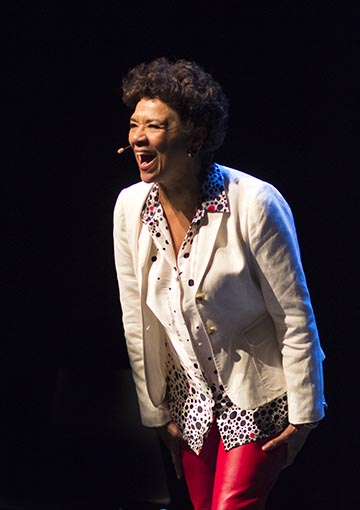To the uninitiated, the theatre for young audiences (TYA) community might seem homogeneous—a network of individuals, companies, and education departments that all call their work “children’s theatre” and all approach theatre, kids, and education in more or less the same way. While TYA often refers to adult professionals performing for young audiences, there are countless niches that overlap and intersect with the TYA world. These include theatre arts instruction and theatremaking for young artists, as well as educational theatre and theatre for social change.
TYA is a big tent, full of artists, educators, administrators, producers, presenters, and publishers. There are organizations completely dedicated to TYA and those for whom TYA is a small part of their overall programming. The lines that separate these identities can be fuzzy, and the nuances between various terms like TYA, children’s theatre, and family theatre can seem slippery too. My aim with these monthly American Theatre columns has been to highlight the many different practices that can fall under the TYA umbrella.
Earlier this month, TYA/USA brought members of this varied field together for the biannual One Theatre World conference. Billed as “the most significant gathering of TYA professionals in North America,” the conference took place May 3–6 across San Francisco, Berkeley, and Oakland, Calif., with the theme “Innovate/Activate.” More than 200 people representing more than 100 organizations from across the country attended, demonstrating the great variety of TYA and its potential to turn a range of disparate ideas into art and action.
In keeping with the wide range of interests and specializations represented at the conference, diversity was a major topic throughout the week. The conference began with a performance from Oakland-based AXIS Dance Company, a contemporary dance ensemble made up of disabled and non-disabled performers. The company performed a program which introduces young audiences to concepts like choreography and improvisation, as well as discusses disability. “A first- or second-grader could see this show and would just think, ‘This is what dance is,'” reflected Marty Johnson, artistic director of iTheatrics and co-chair of the conference.

Conversations about diversity continued in a variety of forms, with breakout sessions covering strategies for creating more racially diverse programming and models for creating theatre for children with autism. At the Orlin Corey Medallion event, an annual award ceremony sponsored by the Children’s Theatre Foundation of America that took place at One Theatre World, Brain Guehring received a medallion for both his work as education director of Omaha Theater Company and as the founder of Pride Players, a group that “uses improvisation to create songs, poetry, monologues, and skits that explore what it means to be a gay, lesbian, bisexual, transgender, or straight-allied teen in Omaha.”
This year’s winner of the national Young Playwrights for Change contest, a middle-school playwriting contest co-sponsored by TYA/USA, was The Principle by Fletcher Fraher, a play about a boy who attacks a transgender student in a school hallway. The play received a staged reading during the conference with local professional actors, and TYA/USA flew Fraher and his family to the Bay Area from Chicago to see it. There was also a TYA performance from Golden Thread Productions and spoken word performances from the teen members of the San Francisco-based Youth Speaks, focusing on issues of identity, inclusion, and discrimination.

Building skill sets outside of theatre and education was another strong thread throughout One Theatre World. Breakout sessions covered methods for successful collaborations, ways to better engage the media, trauma-informed training for teaching artists, and compassionate resilience when working with at-risk youth. Robin Sohnen also stressed the role of compassion in TYA when she accepted an Orlin Corey medallion for Each One Reach One, a San Francisco nonprofit that brings arts education to incarcerated youth. “Plays allow kids to be vulnerable and courageous in a place where that’s not accepted,” she said. “They help all of us understand the issues these kids deal with, often all alone, and often more than just incarceration.”
The conference gave special attention to the importance of arts lobbying by featuring Brad Erickson, the California representative for Americans for the Arts and executive director of Theatre Bay Area, as a guest speaker. Erickson encouraged conference attendees to lobby their elected officials, and warned against taking any politician’s position on the arts for granted. He also urged his audience to retire the “arts equals jobs” argument. “Yes, the arts have economic impact, but so does every sector,” he explained. “We have to talk about how the arts change lives, and we have to be able to talk about the deep value it brings to communities when they invest in the arts. ‘Investing’ is the word we should be using.”
The conference also gave TYA professionals a chance to reflect on their work and the state of the field. Breakout sessions included an education director roundtable, a conversation about quality in TYA, and a town hall-style meeting about how TYA/USA can best support its members.
Sean Fenton, director of WolfBrown’s Intrinsic Impact audience feedback program, gave a presentation on the value of quantitative audience data. Fenton explained how, even with limited resources, TYA companies can collect both audience demographics and audience responses to what they see onstage. This information helps companies better understand the impact they have on their communities. “With better data, we can better tell how theatre changes lives,” he said. “TYA is impactful in ways we’re only beginning to understand.”
Considering how complicated defining TYA can be, it’s not surprising that the conference’s two most prominent speakers don’t fit neatly into a TYA box. Sonia Manzano, who for more than 30 years played Maria on “Sesame Street,” gave a warm and candid keynote speech about her career in children’s television. She also reminded attendees to respect young audiences, saying, “Kids want to be a part of the real world. They have their own answers and ways of looking at the world.”
Tim Federle is a writer whose résumé includes self-help books, YA novels, and Broadway shows (Tuck Everlasting), and his speech was the conference’s culminating event. While not all of his work is specifically for young audiences, he told the group that “to create work for the next leaders of this country is the greatest possible job that you can have.”
While TYA professionals might differ in a number of major ways, that’s one statement on which they can all agree.


